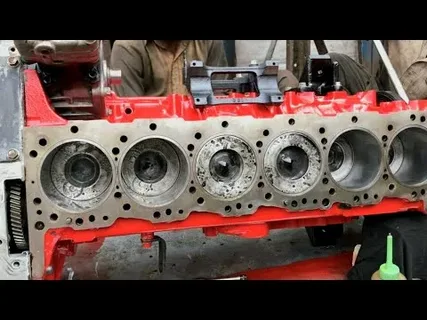Introduction
Car engines are like the heart of your vehicle. Just like our heart needs care and check-ups, the engine also needs attention from time to time. If your car is not running smoothly or you’re noticing problems like loss of power, smoke from the exhaust, or increased fuel use, then it might be time for an Engine Overhauling and Rebuild .
In this blog, we will explain what engine overhauling is, why it is important, and how it can make your car perform better. Everything is explained in simple words so anyone can understand.
What is Engine Overhauling?

Basic Meaning of Engine Overhauling
Engine overhauling means taking the engine apart, checking all the parts, cleaning them, fixing or replacing any damaged parts, and putting it all back together. It’s like giving your car engine a fresh life.
There are two main types of engine overhauls:
- Partial Overhaul: Only the top part of the engine (called the cylinder head) is repaired or cleaned.
- Complete Overhaul: The whole engine is taken apart and checked completely, including pistons, crankshaft, valves, and other inner parts.
When Does a Car Need an Engine Overhaul?
You may need to overhaul your engine when:
- The engine starts making strange noises.
- It takes more fuel than usual.
- There is blue or black smoke coming from the exhaust.
- The car is not giving enough power.
- The engine oil needs to be topped up very often.
- The car does not start easily or shakes a lot.
These signs tell you that something is not right inside your engine. Overhauling helps to fix the problem from the root.
Why Engine Overhauling is Important
Increases Engine Life
Just like humans need a proper diet and rest to live longer, an engine needs proper care too. Overhauling removes old, worn-out parts and replaces them with new ones. This helps the engine last longer and stay healthy.
Saves You Money in the Long Run
At first, an engine overhaul may sound expensive. But think about the cost of buying a new car or a new engine. Overhauling helps avoid bigger problems in the future, which could cost a lot more. It is a smart choice that saves money over time.
Makes Your Car Safer
A faulty engine can suddenly stop in the middle of the road. This can be dangerous for you and others. Overhauling makes the engine strong again, which means the car runs smoothly and safely.
How Engine Overhauling Improves Performance
Now let’s talk about the main point—how engine overhauling actually improves your car’s performance.
Better Fuel Efficiency
One of the biggest changes you’ll notice after an engine overhaul is better fuel economy. Old engines burn more fuel because the parts are not working properly. After overhauling, all parts work smoothly, and your engine uses fuel more efficiently. This means you get more kilometers per liter.
More Power and Speed
When engine parts like pistons, valves, and cylinders are worn out, your car will feel weak. It may not go up hills easily or speed up as it used to. Overhauling replaces or repairs these parts, giving your engine full power back. Your car will feel stronger and faster.
Smoother Driving Experience
An engine in good shape gives you a smooth and quiet drive. After overhauling, the engine runs more quietly, and you will feel less vibration. It feels almost like a new car.
Less Smoke from the Exhaust
If your car is releasing dark smoke, it’s a sign that the engine is burning oil or fuel the wrong way. After overhauling, these problems are fixed. Your car will release much less smoke and be more eco-friendly.
No More Overheating
Old engines overheat easily. This can cause serious damage. During an overhaul, parts like the radiator, coolant pipes, and gaskets are checked. After the service, your engine stays cool even on long drives.
Stronger Acceleration
After an overhaul, you’ll notice that the car picks up speed faster. That’s because the engine is now working at its best. If your car used to struggle while overtaking other cars or climbing up steep roads, that issue will go away.
What Happens During an Engine Overhaul?
Step-by-Step Process
Here is what usually happens when you take your car for engine overhauling:
1. Engine Removal
The engine is removed from the car body and placed in a clean workspace.
2. Engine Disassembly
All the parts are taken apart carefully. Each part is then inspected to check if it is damaged or worn out.
3. Cleaning
All the parts are cleaned properly using special tools and liquids. This helps to remove any carbon build-up, dirt, or oil deposits.
4. Replacement of Damaged Parts
Any part that is broken or worn is replaced. This can include pistons, rings, gaskets, bearings, valves, and more.
5. Reassembly
Once all the parts are cleaned and replaced, the engine is put back together with care.
6. Testing
The engine is tested before being placed back in the car. This ensures it is running properly and no issues are left.
7. Reinstallation
After successful testing, the engine is placed back in the car, and the car is tested again on the road.
Things to Consider Before Engine Overhaul
Choose a Trusted Mechanic
Engine overhauling needs skill and experience. Don’t go to just any garage. Choose a trusted auto service center with trained mechanics.
Use Genuine Parts
Always ask for original or high-quality parts. Cheap parts may not last long and can cause more problems later.
Ask for a Full Report
After overhauling, ask the mechanic to give you a full report of what was done. This will help you understand the work done and keep a record for future use.
Check Warranty
Some service centers offer warranty on engine overhaul. This means if there’s any problem after the service, they will fix it without extra cost. Always check this before giving your car.
Benefits of Regular Engine Maintenance
Even after the overhaul, you should continue taking care of your engine.
Regular Oil Changes
Change your engine oil as advised. Fresh oil keeps the engine parts lubricated and prevents wear and tear.
Use Good Quality Fuel
Poor quality fuel can damage your engine slowly. Always fill up from trusted petrol stations.
Keep an Eye on Warning Lights
If the engine light or oil light on your dashboard turns on, don’t ignore it. Get it checked immediately.
Don’t Delay Small Repairs
Fixing a small issue today can save you from big repairs later. Listen to your car and take it for a check-up when needed.
Conclusion
An engine overhaul is one of the best ways to bring your old or tired car back to life. It helps improve fuel efficiency, boosts engine power, reduces smoke, and gives you a smoother and safer drive.
For more insightful articles related to this topic, feel free to visit techners.net





Leave a Reply